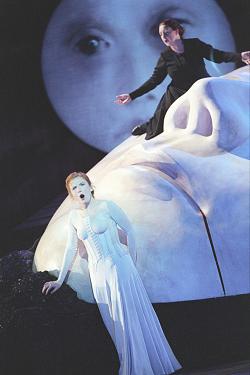|
<< -- 3 -- Roderic Dunnett UNALLOYED GENIUS

By contrast the women -- Euryanthe in pure (and in Act III, helped by
Jennifer Tipton's lighting, sullied) white, Lauren Flanagan's
spidery Eglantine (not, I felt, as well sung or convincingly acted as some
opined) in aggressive, spidery black, each lend the scene some 'colour',
or at least, definition. Much of Macfarlane's splendid, consciously
solid, dourly pastel sets -- a series of beige-grey-brown spikes (spiky trees,
spiky spears, spiky knives, shaped and coloured like soily icicles), beige
chairs, beige tables, beige rooms, plus thick walls, heavy objects, sturdy
bodies) -- maintained, powerfully, this forbidding feel; big blocks, like
the brains of the apparently mindless, almost Neanderthal militaristic society
that peoples them; so does Macfarlane's one splurge of backdrop colour :
a starry dark blue sky with what seems to be a weeping, or at least dewy-eyed,
moon.
This grieving moon-face is no casual decoration. It is a face with a
function, for possibly Jones and MacFarlane's most striking coinceit
of this riveting evening was the tomb of 'Emma' -- Adolar's suicide
sister, presumably a teenager like Euryanthe : a massive 'shape'
of alabastrine white block, in the shape of an elephantine 'beached'
human face. Not only is Macfarlane's moon-face, wanly gazing down,
a mirror of this, wrenched from the massively three-dimensional into an
almost Jugenstil two-dimensional vertical. It has the crucial effect of
putting the Emma story -- purportedly the central problem in Helmina
von Chezy's linguistically challenged libretto -- right at the heart
of the opera.

Anne Schwanewilms as Euryanthe with Lauren Flanagan (above) as the evil Eglantine in the Richard Jones - Mark Elder Glyndebourne 'Euryanthe'. Photo: Mike Hoban
|
Euryanthe, Eglantine and later, even Lysiart climb all over this ominous
block, visually immersing themselves, almost caking themselves, in it. A
brilliant stroke; for the problem (pace received opinion) is categorically
not the Emma saga's ineptness (how easily Wagner might have
served up something similar; in a sense The Flying Dutchman unlocks
something similar); or its gratuity (it isn't, it's central);
rather, the Emma explanation is psychologically astute. But the way
it is often seen as something to be played down often renders it, in production,
superfluous, tiresome, and embarrassing.
Weber, however, goes for it hell-for-leather, allocating some of his
most evocative music to this scene: it's not as if he thought
it weak.
Continue >>
Copyright © 28 July 2002
Roderic Dunnett, Coventry, UK
 RODERIC DUNNETT ON THE RESIGNATION OF NICHOLAS PAYNE
GLYNDEBOURNE FESTIVAL AND GLYNDEBOURNE TOURING OPERA WEBSITE
RODERIC DUNNETT ON THE RESIGNATION OF NICHOLAS PAYNE
GLYNDEBOURNE FESTIVAL AND GLYNDEBOURNE TOURING OPERA WEBSITE
|

